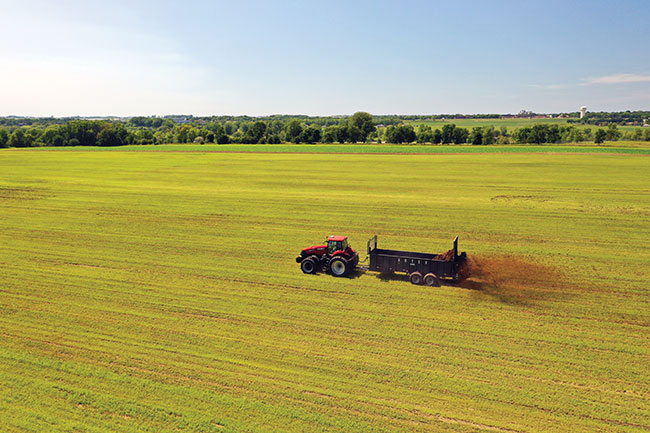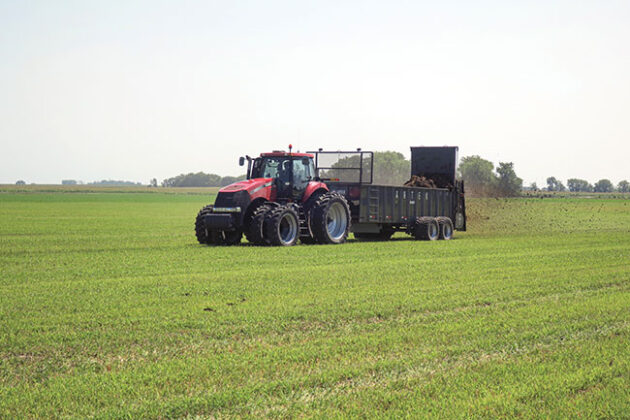
Features
Applications
Dairy
Don’t overdo it
The importance of accuracy when applying manure to alfalfa and grass hay.
June 20, 2023 by Jeff Tribe
 Solid manure is applied to a Minnesota field.
Solid manure is applied to a Minnesota field. Melissa Wilson’s enthusiasm for the benefits of manure application on alfalfa and grass hay is no laughing matter.
But Wilson, an associate professor and extension specialist in manure nutrient management and water quality with the University of Minnesota does sum it up that way.
“I kind of joke, manure is kind of like a multivitamin and probiotic for your soil,” says Wilson. “It’s not just fertilizer, it has the carbon, the microbes, it helps with the whole ecosystem.”
As effective as a modern agricultural translation of replenishing the soil with animal by-product can be however, she cautions mindful moderation is required.
“You can overdo it with manure too.”
Similarly, John Lory, associate professor of extension, division of plant sciences and technology with the University of Missouri and nutrient management specialist for Missouri says manure application should be quantified as accurately as possible, within the broader context of a nutrient management plan to maximize value while diminishing potential concerns.
“As with anything else, it’s the figuring out of how to balance competing needs.”
In essence, Wilson’s career centers around balancing the competing needs between cost and environmentally effective agricultural production.
“I just love the idea of finding how [we can] best grow our food while maintaining our streams and rivers.”
A small-town Pennsylvania native whose school project on water quality led through a doctoral dissertation on absorbing nutrients and maintaining them in place through cover crops, and then teaching nutrient management at the University of Maryland, she says her current focus allows job security – “There is always going to be manure,” Wilson says with a smile – along with a fascinating and productive area of study. There’s an increasing requirement to effectively close the loop on recycling its beneficial nutrients – as Wilson puts it, “Getting the best bang for your buck out of it.”
Manure seems to be most beneficial to alfalfa and grass hay in situations where soil fertility is low, says Wilson.
“If fertility is high, manure doesn’t seem to benefit quite as much.”
There is also an ‘entourage effect’ quality to manure, secondary or micronutrients beyond the most recognizable elements contributing to its overall efficacy. “Boron, things like that,” adds Wilson.
Grassier hay stands have a greater requirement for regular nitrogen application to boost production, compared to alfalfa, which can meet its nitrogen requirements through symbiotic fixation. Alfalfa will, however, preferentially source nitrogen from the soil and sources including manure if available.
“If you have an alfalfa/grass mix and apply manure, your grass may take over,” says Wilson. “Grass hay especially just loves manure.”
Grassier hay’s rhizome roots are also more tolerant of liquid injection, seeming to regenerate better after being cut over legume alfalfa, leading to a contemporary research project.
“We’re looking at traffic-tolerant (alfalfa) varieties right now.”
Manure-based nutrients can be ‘leaky’ says Wilson, the goal of holding them effectively in place instead of migrating to watercourses and elsewhere high on the list. Deep alfalfa roots are effective in holding nitrogen in place, less ‘leaky’ than an annual such as corn for instance. Wilson also encourages farmers to apply manure on fields where there will be minimal runoff during storm season. Freak two- or three-inch rain events are far more frequent than formerly in her state of Minnesota, and she encourages farmers everywhere to ‘keep an eye on the forecast.’
“Think about how you are going to use best management practices to use manure in your system while protecting water quality.”
Old farm sites can be identifiable on soil test maps through high ‘legacy’ phosphorus and potassium levels in close proximity to the former barn. Modern equipment is more conveniently mobile than a horse-drawn manure spreader for example, however a variable cost/time effectiveness calculation featuring machinery, fuel and fertilizer prices and time does apply.
“In years like this where fertilizer prices are high, it may pay to haul it further out if you have the space. It’s really pencilling it out and seeing where you need the nutrients and how much would they cost if you used fertilizer.”
Given manure properties may not precisely line up with plant requirements, Wilson sees it as ‘part of the package,’ recognizing manure on its own may represent over-applying something and under-applying something else.
“And there’s where fertilizers come in to even things out.”
Lory says manure application reflects a variable calculation maximizing nutrient value, meeting but not exceeding a crop’s requirements against the backdrop of timing and the fact a farmer simply may have to get it out of storage and onto a field.
“These three things on a given day will lead you to different locations.”
Manure can present challenges when compared to the guaranteed nutrient composition of commercial fertilizers. Manure application within a nutrient management plan requires regular testing over time on destination soil, to identify and match requirements with the product. Testing or using test record results on well mixed or agitated manure resulting in as consistent a product as possible allows farmers to assess how much to apply to meet and not exceed soil requirements. Uniformity in application is another key, adds Lory.

In some situations, it can pay to haul manure further,
depending on where, exactly, nutrients are needed.
“At that point you can kind of treat it as a fertilizer.”
Grass hay or the fescues he is most familiar with benefit more from manure application than alfalfa.
“They need fertilizer or they’re not going to grow. Both will use the manure nitrogen, it’s just [that] one doesn’t need it.”
Farmers who have to get manure out onto alfalfa may accept the fact they are loading up on phosphorus and potassium, and essentially writing the nitrogen off says Lory.
“The nitrogen value is questionable. You’re not getting full value – but whoever does,” he adds with a laugh.
Balancing phosphorus and potassium from manure alone can be problematic, in that rates based on annual alfalfa phosphorus requirements may not provide sufficient potassium. Meeting the latter through manure alone rather than supplemental commercial potassium, for example, may result in an overabundance of unutilized phosphorus, requiring effective management to prevent negative water quality effects from runoff or erosion.
Lory also cautions manure application may negatively mitigate the competitive advantage alfalfa enjoys through fixing its own nitrogen. Whether including grass or weed seeds or not, application may encourage competition of existing or new growth. Conversely, manure application may be used as a tool to help boost yield in older, thinner stands of alfalfa through encouraging grass production.
Lory also sees application during a stand’s later years as a potentially positive benefit prior to rotation to, for example, corn or silage.
“Take advantage of that transitional period to get some nitrogen down.”
Application should also be timed to prevent damage to stands, either physically through machinery transit, large smothering clumps of solid manure or alfalfa’s sensitivity to the higher salt content which may be present in liquid manure, particularly originating in the beef or dairy industries.
“Get it on immediately after cutting to reduce contact with that young growth, because that young growth is sensitive
to salt.”
In conclusion, Lory recommends optimizing manure’s valuable nutrients by selecting application areas where they are needed most.
“If you do go on alfalfa, you want to follow a few rules so as to not damage your stand.” •